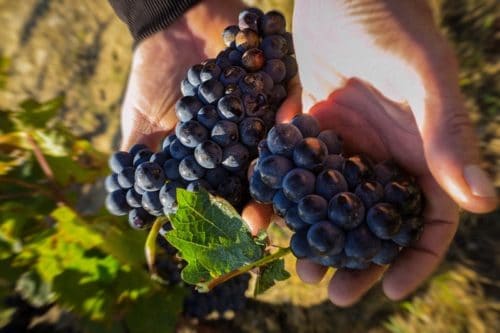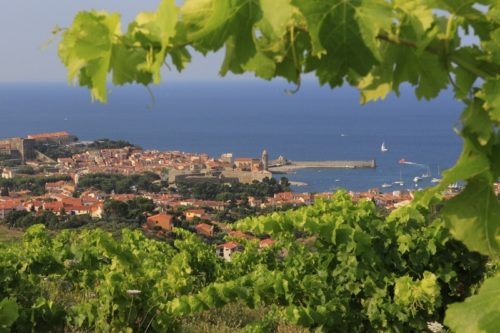Discover The Languedoc Wine Region of France
Last Updated on December 17, 2019.
The Languedoc-Roussillon region is France’s largest wine producing region and vineyard area, with roughly one-third of all French wines produced here. The greater Languedoc-Roussillon region is also the largest vineyard area in the world with more than 21,000 wine estates and 246,000 hectares of vineyards in the region. Of this, the Languedoc AOP makes up around 40,000 hectares with its 36 AOPs, and accounts for 11% of Languedoc-Roussillon wines. Culturally and geographically distinct from Roussillon, the Languedoc is home to over 2,000 producers, 80 co-ops and 450 private winemakers.
The Languedoc, which received its AOP status in 2007, has long been a grape and wine producing region in France. It was first planted by the Greeks in the 5th Century BC and later cultivated further by the Romans. In the 17th century with the completion of the Canal du Midi — which connected the Mediterranean to the Atlantic — wine production in the region increased.
However, it was in the late 19th century when a combination of factors led to the region becoming the largest producer of wine in the country. The country’s rail lines were built and distribution of wine to the north increased demand for wine production, while around the same time the vineyards were being planted for higher yields on American rootstock following the Phylloxera epidemic. By the early 1900s, 21 million hectoliters of wine was being produced, making this the largest volume production of table wine in France.
In 1938, Blanquette de Limoux was granted AOP status, the first in the region and in 1945, it received the wine of superior quality designation (VDQS). Although, some wine producers were turning focus to quality over quantity, it wasn’t until the 1980s the region overall began to shift its focus. Today this region has prioritized setting standards to improve quality through everything from vineyard management and yields, to winemaking methods.
Additionally, a significant amount of resources are devoted to researching soils and analyzing vineyard sites. Given the affordability of the region and its ability to make a diverse range of wine styles, it continues to attract young winemakers and foreigners to the business. Today, the region accounts for nearly 40% of French wine exports by volume as well as 30% of France’s overall organic wine production. The biggest challenge facing the region today is that of marketing and changing the high-volume perception of the region.
The Climate and Geography of the Languedoc (Terroir)
The Languedoc is situated along the Mediterranean coast running from Spain in the South to Nimes in the North. Owing to its proximity to the Mediterranean Sea, the region is known for its typically hot summers and mild autumns, springs and winters.
However, as a vast geographical region it also has numerous micro-climates including mountainous regions in the north, coastal regions along the Mediterranean and southern regions with temperature variations and lots of sun. The central region has little rain and higher temperatures, and the western region has more continental and Atlantic influences. Rain fall is low throughout the region, but the calcareous soils help to retain the water for a healthy root system.
The soils too are diverse. While the dominant soil types are clay and limestone, calcareous soils, gravel and schist are also found throughout.
The Wines of the Languedoc
Seventy-six percent of the wines produced in the Languedoc are Red Wines, mostly consisting of blends. However, Rosé and White Wines as well as Sweet and Sparkling Wines can be found.
The vins doux naturel sweet wines are typically comprised of Muscat, including both Muscat Blanc à Petits Grains, considered the highest quality Muscat grape, and the Muscat de Alexandria, one of a dozen grapes with the Muscat name.
As for the sparkling wines, many believe that traditional method sparkling wine originated here in the 1530s, prior to Champagne. The two types of sparkling wines found today include Crémant de Limoux and Blanquette de Limoux. Crémant wines are made in the traditional method and must include a minimum of 90% Chardonnay and Chenin Blanc. These wines rest on the lees for a minimum of 15 months. By contrast, Blanquette sparkling wines are made with the Mauzac grape, which must comprise 90% of the blend. By contrast to the Crémant, Blanquette wines only require a minimum of nine months on the lees.
Well-Known Sub-Regions
The Languedoc can be viewed as a three-tier pyramid with the Crus appellations at the peak, Grand Vins in the middle and Regional AOP wines at the base. The most well-known regions include the Cobières, which spans Carcassonne to Narbonne and from the Pyrenean foothills to the base of the Black Mountains. The slopes here are sheer, the climate dry Mediterranean. The region has been sub-divided into 11 sub-regions. Of these, the Boutenac has its own Cru AOP. Wines of Cobières are generally red blends based on Carignan with garigue-infused flavor profiles with red and black fruits and intense color.
Minervois lies in the foothills of the Black Mountains in the Massif Central and features a vast south-facing amphitheater with a changing climate owing to Atlantic influences. Climatic variability is accentuated by prevailing winds, locally known as Cers and Marin, and is coupled with the diversity of soils which characterize the wine. Known for its red wines from old, low-yielding vines of Carignan, Grenache and Syrah. The wines of Minervois are dense and rich, particularly from the area’s Cru, Minervois La Livinière.
Near Béziers, the Faugères AOP vineyards are about one-eighth the size of Cobières and produce wines from old Carignan vines with spicy and earthy flavor profiles. Cru Faugères is found on a terroir which is unique in the Languedoc with exceptional shale soils. These help mediate the intense Mediterranean summer heat. And for white wines, Picpoul de Pinet is best known for its wines from the Picpoul grape with production of more than 61% of the region’s white wine. This is a centuries old wine producing region with wines characterized by floral and citrus fragrances, and a liveliness on the palate.
The Languedoc AOP
Crus du Languedoc
- Cobières Boutenac
- La Clape
- Minervois La Livinière
- Terrasses du Larzac
- Pic Saint-Loup
Grand Vins du Languedoc
- Cabardès
- Clairette
- Corbières
- Faugères
- Fitou
- Limoux
- Malepère
- Minervois
- Muscat de Frontignan
- Muscat de Lunel
- Muscat de Mireval
- Muscat de Saint Jean de Minervois
- Picpoul de Pinet
- Saint-Chinian
- Saint-Chinian Berlou
- Saint-Chinian Roquebrun
Languedoc AOP – Dénominations Régionales
- Languedoc-Cabrières
- Languedoc-Grés de Montpellier
- Languedoc-La Méjanelle
- Languedoc-Montpeyroux
- Languedoc-Pézenas
- Languedoc-Quatourze
- Languedoc-Saint-Christol
- Languedoc-Saint-Drézéry
- Languedoc-Saint-Georges-d’Orques
- Languedoc-Saint Saturnin
- Languedoc-Sommières
The Grapes of the Languedoc
More than 50 grape varieties, from native to international can be found within the Languedoc. Among the most prominent are those also common to the Rhône. Including Grenache, Syrah, and Mourvèdre as well as Cinsault and Carignan. These wines are generally characterized by red fruit, spices and the area’s renowned garigue blend of herbs, including rosemary, thyme, sage, lavender and juniper.
Other must-know grapes of the Languedoc include:
- Bourboulenc
- Cabernet Sauvignon
- Chardonnay
- Chenin Blanc
- Clairette
- Grenache Blanc
- Macabeu
- Malbec
- Marsanne
- Mauzac
- Merlot
- Muscat
- Picpoul
- Rolle
- Roussanne
Written By Kristy Wenz
Kristy Wenz is a Wine & Travel Writer for Winetraveler and DipWSET Candidate. She first developed a passion for wine travel at random in Southern California. Since that first experience, Kristy has explored wineries in over 20 states from coast-to-coast as well as multiple European wine regions. When she’s not writing about wine, wine traveling or updating her cellar in Vivino, she can likely be found sipping a Cab Franc from her travels while cooking dinner with her family.

